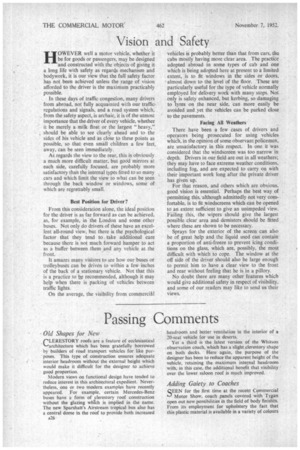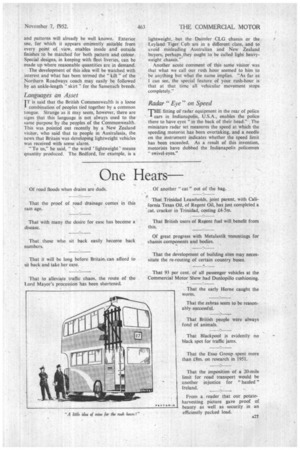Passing Con rnents
Page 28

Page 29

If you've noticed an error in this article please click here to report it so we can fix it.
Old Shapes for New
CLERESTORY roofs are a feature of ecclesiastical architecture which has been gratefully borrowed by builders of road transport vehicles for like purposes. This type of construction ensures adequate interior headroom without the external height which would make it difficult for the designer to achieve good proportion.
Modern views on functional design have tended to reduce interest in this architectural expedient. Nevertheless, one or two modern examples have recently appeared. For example, certain Mercedes-Benz buses have a form of clerestory roof construction without the glazing whirch is implied in the name. The new Sparshatt's Airstream tropical bus also has a central dome in the roof to provide both increased headroom and better ventilation in the interior of a 20-seat vehicle for use in deserts.
Yet a third is the latest version of the Whitson . observation coach, which has a slight clerestory shape on both decks. Here again, the purpose of the designer has been to reduce the apparent height of the vehicle, retaining the maximum internal headroom with, in this case, the additional benefit that .visibility • over the lower saloon roof is much improved.
Adding Gaiety. to Coaches
CEEN for the first time at the recent COmmercial
Motor Show, coach panels covered with Twin open out new possibilities in the field of body finish-es. From its employment for upholstery the fact that this plastic material is available in a variety of colours
and patterns will already be well known. Exterior use, for which it appears eminently suitable from every point of view, enables inside and outside finishes to be matched for both pattern and colour. Special designs, in keeping with fleet liveries, can be made up where reasonable quantities are in demand.
The development of this idea will be watched with interest and what has been termed the " kilt " of the Northern Roadways coach may easily be followed by an ankle-length "skirt" for the Sassenach breeds.
Languages an Asset
IT said that the British Commonwealth is a loose :I combination of peoples tied together by a common tongue. Strange as it may seem, however, there are signs that this language is not always used to the same purpose by the peoples of the Commonwealth. This was pointed out recently by a New Zealand visitor, who said that to people in Australasia, the news that Britain was developing lightweight vehicles was received with some alarm.
"To us," he said, " the word lightweight ' means quantity produced. The Bedford, for example, is a lightweight, but the Daimler CLG chassis or the Leyland Tiger. Cub are in a different class, and to avoid misleading Australian and New Zealand buyers, perhaps they ought to be called light heavyweight chassis."
Another acute comment of this sane visitor was that what we call our rush hour seemed to him to be anything but what the name implies. "As far as I can see, the special feature of your rush-hour is that at that time all vehicular movement stops completely."
Radar "Eye" on Speed
1HE fitting of radar equipment in the rear of police cars in Indianapolis, U.S.A., enables the police there to have eyes "in the back of their head." The miniature radar set measures the speed at which the speeding motorist has been overtaking, and a needle on the instrument indicates whether the speed limit has been exceeded. As a result of this invention, motorists have dubbed the Indianapolis policemen "swivel-eyes."




























































































